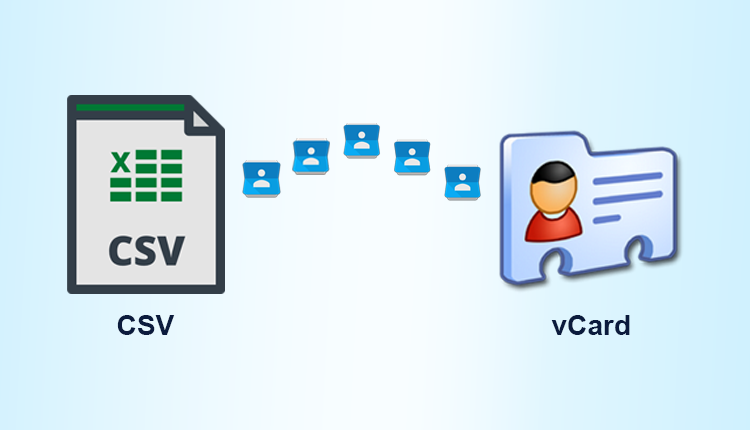How to Export CSV Contacts to vCard – Complete Method

Are you weary of using ineffective approaches to Export CSV Contacts to vCard? Do you want a practical approach to carry out the conversion operation without risking the data’s integrity? Don’t worry, you’ll find everything you need to complete the assignment as quickly as possible here.
Because the data is kept in columns and rows, the CSV format is commonly used to store contacts, tables, and other similar data. However, you may need to export CSV contacts to VCF on occasion.
This is required to utilize or access contacts in applications such as mobile phones, Gmail, Thunderbird, and others that do not accept CSV files. VCF, or vCard, is a file format for storing contact information such as name, picture, address, email address, phone number, and URLs.
It’s also supported by a variety of email clients and cloud services, as previously noted. The conversion procedure is not well understood by many individuals. Let’s have a look at some of the options.
What are the Best Methods for Export CSV Contacts to vCard?
The following are the most beneficial ways for the operation:
- Use the manual method
- Step 1: Import contacts from a CSV file
- Step 2: Converting the Files to VCF Format
- The Professional Approach
Because there are no direct native ways to execute the work, the first technique, which is the manual solution, requires a user to take two steps. To begin, save the contacts from the.csv file and then export CSV contacts to vCard file.
The second technique will convert the files to VCF format for you, making it a simple and time-saving procedure. Let’s have a look at how each of these techniques functions.
Converting Outlook Contacts from CSV to VCF
The technique is separated into two sections here; study the steps as follows:
Part 1: Importing CSV Contacts
- Go to the Windows Icon and type in Contacts.
- Select the Import tab in the contacts pane.
- Select CSV as the export format and click Import.
- Next, choose the contacts you wish to export from the list and click Next.
- Click the Finish button to complete the process.
After you’ve export CSV contacts to VCF file, you’ll need to convert them to an a.vcf file.
Follow the procedures outlined in the next section to learn how to convert CSV contacts to vCard.
Part 2: Convert the Files to VCF Format
- Select the Export option from the same Contacts Window.
- Click the Export button after selecting the vCard (folder of. vcf files) option.
- Go to the location where you stored the CSV files.
- Select a destination location for the converted files or create a new folder.
- When you click Finish, all of your files will be converted to VCF format.
There are a few flaws in this strategy, which are discussed in the following section:
- The manual technique saves a separate vCard file for each contact, which can be cumbersome when dealing with a large number of contacts, such as thousands.
- Because this is not a direct technique, users must have a significant amount of time to devote to this procedure.
- To use this strategy, you need to have some technical expertise and a strong understanding of your system.
Export CSV Contacts to vCard with this Pro-Tip
If you don’t want to spend time with the manual approach, don’t know much about the system you’re working on, or need to produce a single vCard file for all of your contacts, the Excel to vCard Converter Tool is the way to go.
This software has algorithms that will assist you in exporting all of the information from a CSV file, including the name, email address, phone number, and so on. The data may be exported in three different vCard versions: v2.1, v3.0, and v4.0 (latest version).
Furthermore, the tool allows users to map CSV and vCard characteristics in order to correctly export all of the data.
What Are the Software’s Conversion Performance Instructions?
To use the tool to Export CSV Contacts to vCard, follow the instructions below:
- Open the app on your Windows OS desktop and select the files to convert using the Browse option.
- To add the files to the tool panel, select them and click the Open button. To go to the next stage, press next.
- In the Excel Fields on the left side of the window, change the order. By selecting the fields in the same order and pressing Next, you can ensure that the vCard Fields are identical.
- If necessary, choose Allow Empty Email Addresses to be imported and create a Single vCard File for All Contacts. Select the vCard format.
- To define a destination path, click the Change button, then select the Make New Folder option and click OK.
- Finally, hit the Convert button to complete the converting procedure.

This is the quickest and easiest approach to export CSV contacts to VCF. It is not necessary to have any technological expertise or experience to use this strategy.
A few last lines
A large number of people are seeking a way to do the conversion procedure. Users have been under a lot of stress as a result of the lack of direct ways. Now you have the option of performing this action in two sections and wasting a lot of time, or you can use software to convert the data quickly.
The manual technique has one significant disadvantage: it produces a vCard for each contact you export, making it difficult to manage. You may get around this by utilizing the software to export CSV contacts to vCard and creating a single file that contains all of the contacts you import.